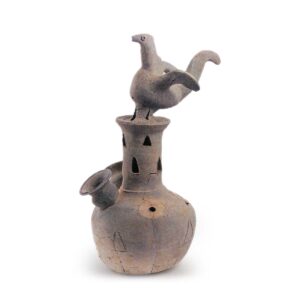
Excavated from Ishizuka No. 2 Tumulus, Chiyoda-machi, Hiroshima 7th century.
7th century.
Total height 53.8cm (Bird) Height 18.0cm, Length 20.2cm (Jar) Mouth diameter 11.9cm, Body diameter 22.6cm, Base diameter 15.8cm
Hiroshima Prefectural Board of Education
Excavated in April 1973, the burial mound is a small circular mound with a diameter of 10 meters and a height of 2 meters. There is a 4.5m-long stone chamber with an iron knife and some Sue vessels inside. Based on the artifacts, it is thought to date to the mid-7th century.
The body of the vessel is a kind of long-necked vase with a stand, and it has four wide-mouthed small jars on its shoulders. The neck is decorated with a two-tiered triangular openwork on all four sides, and the body is also decorated with a triangular pattern in engraved lines, which is a remarkable change from vessels for practical use.
Although not shown in the photograph, it is accompanied by a low, spreading foot measuring 3.7 cm in height. The bird is shown with its wings spread wide, as if about to take flight into the world of the gods. Although it is poorly made, it is so large that it gives the viewer a sense of mystery. It is probably the largest bird-shaped ornament known to date.
One of the centers of distribution of such bird-shaped Sue ware is in Hiroshima Prefecture, where seven examples are known. There are two types of bird-shaped vases, one is a variant of the flat vase and the other is a high cup with the cup part folded over to resemble a body. These are considered to be a kind of local color that differs from the bird-shaped lids of the Tokai region.



